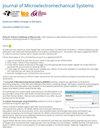使用 Al0.7Sc0.3N 的高可调谐压电谐振器
IF 2.5
3区 工程技术
Q2 ENGINEERING, ELECTRICAL & ELECTRONIC
引用次数: 0
摘要
我们报告了一种使用 Al0.7Sc0.3 N 薄膜的频率可调 Lamb 波压电谐振器。谐振器的频率可调是通过其刚度操纵实现的,而刚度操纵是通过用可变电容终止调谐电极(TE)来实现的。我们制作并鉴定了具有 2、3、4 和 5 个 TE 的谐振器。具有 5 个 TE 的谐振器实现了 24 694 ppm 的最高调谐范围。而 2 TE 谐振器的插入损耗最佳,约为 -6 dB。Al0.7Sc0.3 N谐振器实现的调谐范围(17,783 $\sim $ 24,694 ppm)高于先前研究中的零功率演示。谐振器采用商用 XBAW $^{\mathrm {TM}}$工艺制造,因此适合大规模生产,无需任何特殊的加工步骤或材料。这种谐振器为使用更少的元件处理多通道频率提供了一个平台,从而有望实现现代无线通信系统的小型化。[2023-0193]本文章由计算机程序翻译,如有差异,请以英文原文为准。
Highly Tunable Piezoelectric Resonators Using Al0.7Sc0.3N
We report a frequency tunable Lamb wave piezoelectric resonator using an Al0.7Sc0.3 N thin film. The frequency tuning of the resonator is demonstrated by its stiffness manipulation which is achieved by terminating the tuning electrodes (TE) with a variable capacitor. Resonators with 2, 3, 4, and 5 TE were fabricated and characterized. The highest tuning range of 24,694 ppm was achieved for the resonator with 5 TE. Whereas the best insertion loss of approximately −6 dB was demonstrated by the resonator with 2 TE. The tunning range (17,783
$\sim $
24,694 ppm) achieved by the Al0.7Sc0.3 N resonators is higher than zero power demonstrations in prior studies. The resonators are fabricated using a commercial XBAW
$^{\mathrm {TM}}$
process making it suitable for mass production without any needed exotic processing steps or materials. The resonators are promising for miniaturization of modern wireless communications system by providing a platform to process multi-channel frequencies with reduced components. [2023-0193]
求助全文
通过发布文献求助,成功后即可免费获取论文全文。
去求助
来源期刊

Journal of Microelectromechanical Systems
工程技术-工程:电子与电气
CiteScore
6.20
自引率
7.40%
发文量
115
审稿时长
7.5 months
期刊介绍:
The topics of interest include, but are not limited to: devices ranging in size from microns to millimeters, IC-compatible fabrication techniques, other fabrication techniques, measurement of micro phenomena, theoretical results, new materials and designs, micro actuators, micro robots, micro batteries, bearings, wear, reliability, electrical interconnections, micro telemanipulation, and standards appropriate to MEMS. Application examples and application oriented devices in fluidics, optics, bio-medical engineering, etc., are also of central interest.
 求助内容:
求助内容: 应助结果提醒方式:
应助结果提醒方式:


